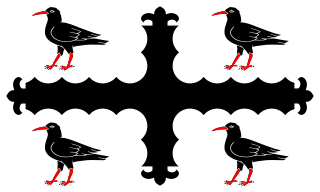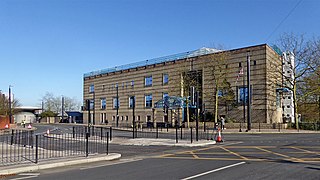
Flintshire, also known as the County of Flint, is one of Wales' thirteen historic counties, and a former administrative county. It mostly lies on the north-east coast of Wales.

Flintshire County Council is the unitary local authority for the county of Flintshire, one of the principal areas of Wales. It is based at County Hall in Mold.
A county hall or shire hall is a common name given to a building that houses the seat of local government for a county.

The Winchester Law Courts is a judicial facility just off the High Street in Winchester, Hampshire, England. As well as accommodating the Crown Court, which deals with criminal cases, the complex also accommodates the County Court and the Winchester District Registry of the High Court.
The North Wales child abuse scandal was the subject of a three-year, £13 million investigation into the physical and sexual abuse of children in care homes in the counties of Clwyd and Gwynedd, in North Wales, including the Bryn Estyn children's home at Wrexham, between 1974 and 1990. The report into the scandal, headed by retired High Court judge Sir Ronald Waterhouse QC, which was published in 2000, resulted in changes in policy in England and Wales into how authorities deal with children in care, and to the settling of 140 compensation claims on behalf of victims of child abuse.

Y Gaer is a municipal structure in Glamorgan Street, Brecon, Powys, Wales. The complex, which includes a museum, an art gallery and a library and incorporates a structure which was once the shire hall for Brecknockshire, is a Grade II* listed building.

The Shire Hall in Agincourt Square, Monmouth, Wales, is a prominent Grade I listed building in the town centre. It was built in 1724, and was formerly the centre for the Assize Courts and Quarter Sessions for Monmouthshire. In 1839–40, the court was the location of the trial of the Chartist leader John Frost and others for high treason for their part in the Newport Rising. The building was also used as a market place. The Shire Hall is owned by Monmouthshire County Council and has audiovisual guides for visitors to Courtroom 1. It is currently used as a Tourist Information Centre and as the offices for Monmouth Town Council, and is open to the public in part.

April Sue-Lyn Jones was a Welsh child from Machynlleth, Powys, who disappeared on 1 October 2012, after being sighted getting into a vehicle near her home. The disappearance of April Jones, aged five, generated a large amount of national and international press coverage. A 46-year-old English man, Mark Bridger, was subsequently arrested and convicted.

The Warwickshire Justice Centre is a Crown Court venue, which deals with criminal cases, as well as a County Court venue, which deals with civil cases, in Newbold Terrace, Leamington Spa, England. The complex also incorporates magistrates' court, a police station, and other agencies such as the Probation Service and Victim Support.

Truro Crown Court is a Crown Court venue which deals with criminal cases at Edward Street in Truro, Cornwall, England. It is a Grade II* listed building.

County Hall is a municipal facility at Raikes Lane in Mold, Flintshire. It was the headquarters of the old Flintshire County Council from 1967 to 1974, the headquarters of Clwyd County Council from 1974 to 1996 and has been the headquarters of the new Flintshire County Council since 1996.

The Shire Hall is a municipal structure in Broad Street, Presteigne, Powys, Wales. The building incorporates a well-preserved courtroom and a museum known as "the Judge's Lodging". Once the judicial centre for Radnorshire, is a Grade II* listed building.

The Stafford Combined Court Centre is a Crown Court venue, which deals with criminal cases, as well as a County Court venue, which deals with civil cases, in Victoria Square, Stafford, England.

The Leicestershire Law Courts is a Crown Court venue, which deals with criminal cases, as well as a County Court venue, which deals with civil cases, in Wellington Street, Leicester, England.

The Wolverhampton Combined Court Centre is a Crown Court venue, which deals with criminal cases, as well as a County Court, which deals with civil cases, in Pipers Row, Wolverhampton, England.

The Derby Combined Court Centre is a Crown Court venue, which deals with criminal cases, as well as a County Court, which deals with civil cases, in Morledge, Derby, England.

The Peterborough Combined Court Centre is a Crown Court venue, which deals with criminal cases, as well as a County Court venue, which deals with civil cases, in Rivergate, Peterborough, England.

Luton Crown Court is a Crown Court venue, which deals with criminal cases, in George Street, Luton, England.

Burnley Law Courts is a Crown Court venue, which deals with criminal cases, and a County Court venue, which deals with civil cases, in Hammerton Street, Burnley, England.

Grimsby Combined Court Centre is a Crown Court venue which deals with criminal cases, as well as a County Court venue, which deals with civil cases, in Town Hall Square, Grimsby, England.



















